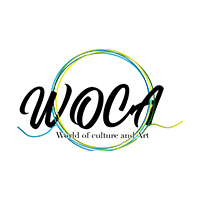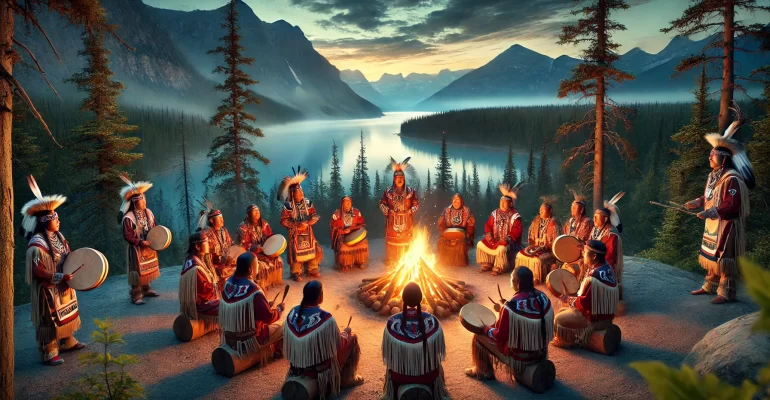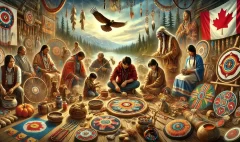Singing Our Stories: The Power and Beauty of Indigenous Songs in Canada
Singing Our Stories: The Power and Beauty of Indigenous Songs in Canada
Hello, music lovers and curious minds! Today, we’re going on an amazing journey into the world of Indigenous songs in Canada. These aren’t just any songs – they’re like magical time capsules filled with stories, wisdom, and the heartbeats of entire cultures. So, let’s open our ears and our hearts as we explore the incredible power of Indigenous songs!
What Makes Indigenous Songs Special?
Before we dive into the different types of songs, let’s talk about what makes Indigenous songs so unique and important. Indigenous songs are much more than just music. They are:
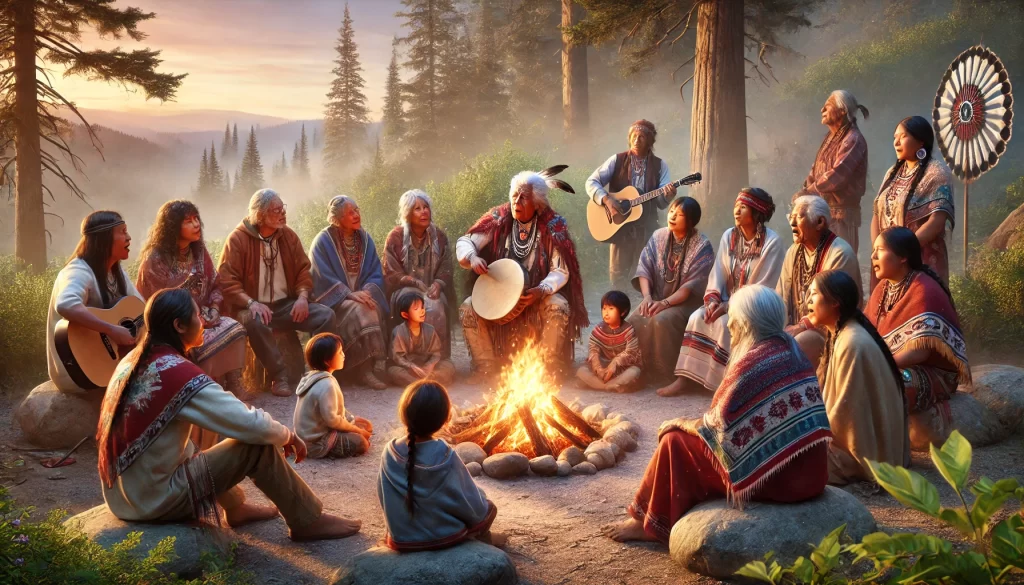
- Living History Books: Songs carry stories and teachings from long ago right up to today.
- Spiritual Connections: Many songs are like prayers, connecting people to the Creator and the spirit world.
- Teachers: Songs pass down knowledge about everything from how to live a good life to which plants are good for medicine.
- Community Glue: Singing together brings people closer and makes communities stronger.
- Healing Medicine: Some songs have the power to help people feel better in body, mind, and spirit.
“Our songs are like the voice of our ancestors,” says Elder Mary Songkeeper. “When we sing, we’re not just making music – we’re keeping our culture alive and strong.”
Types of Indigenous Songs
Indigenous Peoples in Canada have many different kinds of songs. Let’s explore some of them!
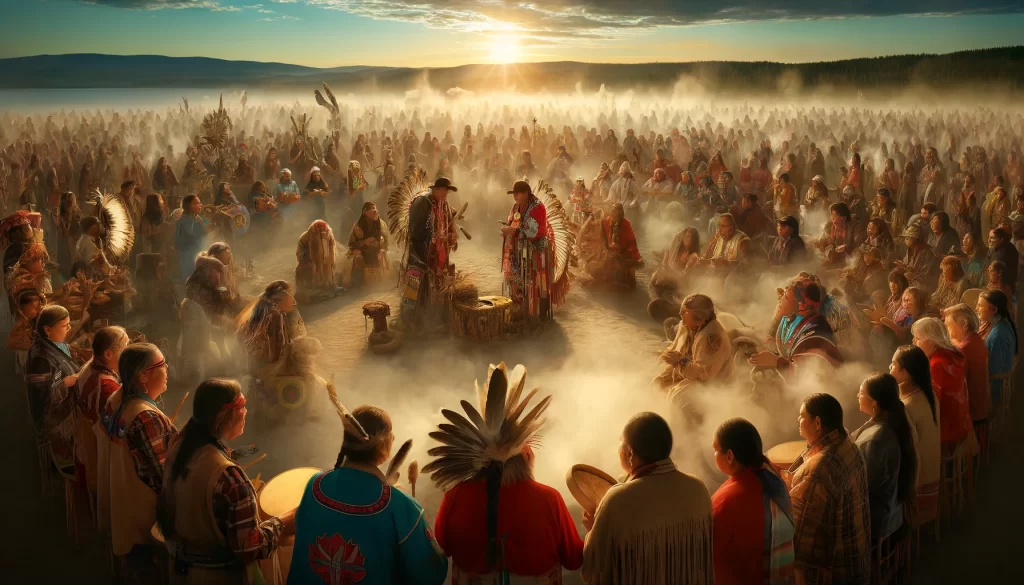
Songs in Specific Ceremonies and Traditions
Now that we know about different types of songs, let’s look at how they’re used in some specific ceremonies and traditions. Remember, these can vary a lot between different Indigenous nations!
Sweat Lodge Ceremony
The sweat lodge is a purification ceremony found in many Indigenous cultures.
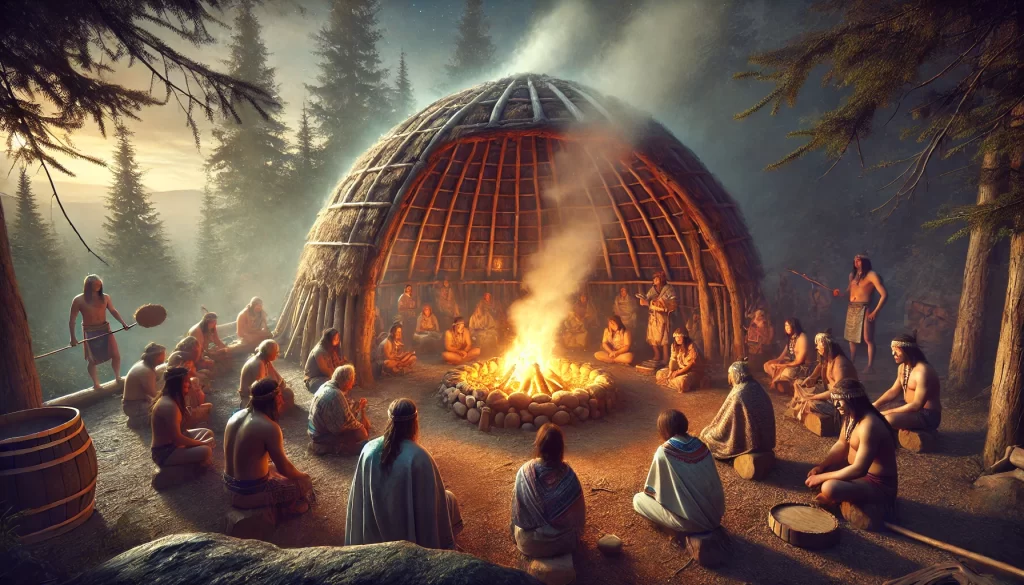
– Songs Used: Special purification songs are sung throughout the ceremony.
– How They’re Used: These songs help create a sacred atmosphere, guide participants through the stages of the ceremony, and call on spiritual helpers.
– Example: In some traditions, there’s a specific song sung when the hot stones (called “grandfathers”) are brought into the lodge. The songs in a sweat lodge are like a roadmap for our spirits,” explains ceremonialist Sarah Cleansoul. “They guide us through the journey of cleansing and renewal.”
Naming Ceremony
Many Indigenous cultures have special ceremonies for giving names to people.
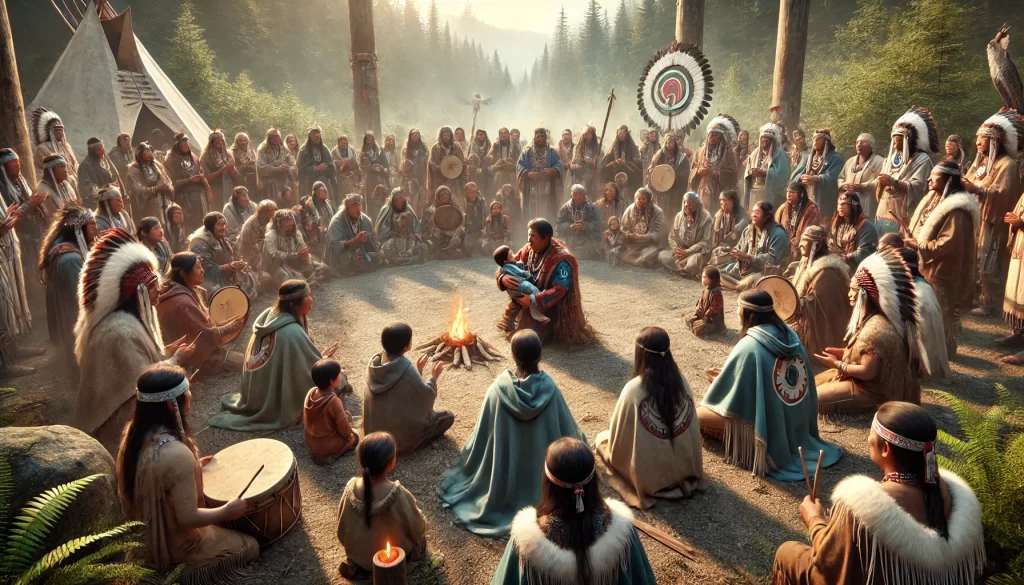
– Songs Used: Name songs, family songs, and blessing songs.
– How They’re Used: A special song might be sung to announce the new name, to honor the family lineage, or to ask for blessings for the person receiving the name.
– Example: In some Anishinaabe traditions, each clan (like the bear clan or the eagle clan) has its own song that might be sung when a child receives a name connected to that clan. “A naming song is like a promise,” says Elder Tom Namegiver. “It connects a person to their name, their family, and their place in the community.”
Sun Dance
The Sun Dance is an important ceremony for many Plains cultures.
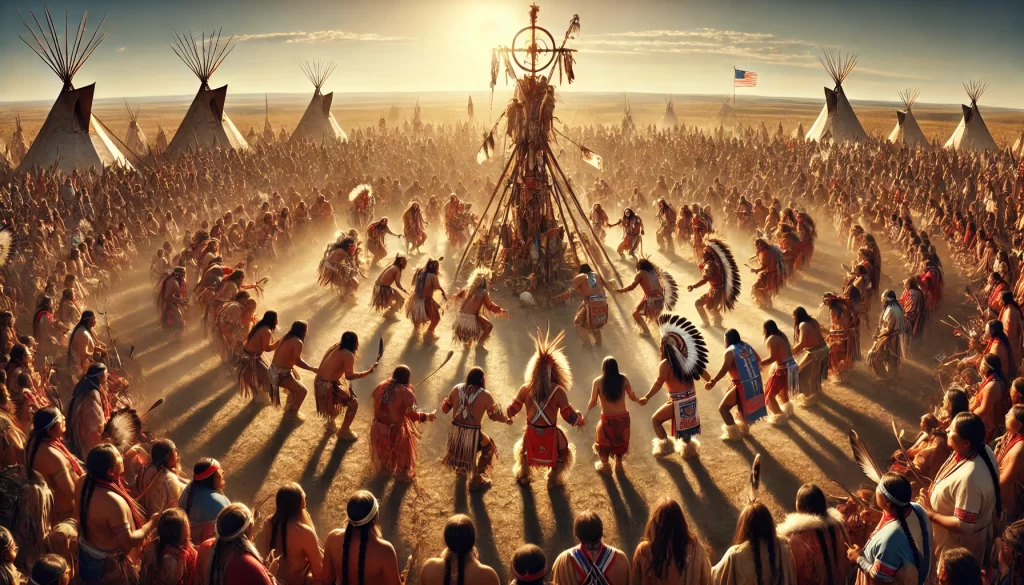
– Songs Used: There are specific songs for each part of the multi-day ceremony.
– How They’re Used: Songs mark different activities, like raising the central pole, dancing, and praying for healing.
– Example: Some traditions have special songs sung only by the pledgers (the people dancing in the ceremony) during their fast.
“The songs of the Sun Dance keep us going when the ceremony gets tough,” shares Sun Dance participant Lisa Strongheart. “They remind us why we’re there and give us strength.”
Potlatch
The potlatch is a major feast and gift-giving ceremony practiced by many coastal nations.

– Songs Used: Family songs, storytelling songs, and songs that declare rights and privileges.
– How They’re Used: Songs might announce the arrival of guests, tell family histories, or accompany masked dances.
– Example: In some traditions, a special song is sung when a chief’s name and position are passed down to a successor.
“Our potlatch songs are like our family albums and history books all rolled into one,” explains Chief Robert Traditionkeeper. “They tell everyone who we are and where we come from.”
Berry Fast
Some Anishinaabe communities practice a berry fast for young women entering womanhood.

– Songs Used: Women’s songs, blessing songs, and songs about plants and berries.
– How They’re Used: Songs might be used to bless the young woman, to teach about medicinal plants, or to celebrate the completion of the fast.
– Example: There might be a specific song sung when the young woman picks her first berry after the fast is over. “The songs of the berry fast are like gentle teachers,” says mentor Mary Moontime. “They help guide young women into their new role and responsibilities.”
These are just a few examples of how songs are woven into the fabric of Indigenous ceremonies and traditions. Each song has its place and purpose, helping to create meaningful experiences and pass down important cultural knowledge.
Ceremonial Songs
These are very special songs used in important ceremonies and rituals.

– What They’re For: Ceremonial songs might be for welcoming new babies, celebrating marriages, honoring people who have passed away, or marking the change of seasons.
– How They Sound: They often have a steady beat and might use special words or sounds that have spiritual meaning.
– Who Sings Them: Usually, only certain people who have earned the right can sing these songs.
“Ceremonial songs are like keys that open doors to the spirit world,” explains ceremonialist John Eaglefeather. “They help us connect with forces bigger than ourselves.”
Storytelling Songs
These songs are like singing storybooks!

– What They’re For: They tell tales about heroes, teach moral lessons, or explain how things came to be.
– How They Sound: They might have a clear narrative structure, with a beginning, middle, and end.
– Who Sings Them: Often, skilled storytellers or elders sing these songs, but anyone can learn them to keep the stories alive.
“When I sing a story song,” says storyteller Lisa Talespinner, “I can see the characters come to life in my mind. It’s like watching a movie, but with your imagination!”
Healing Songs
Some songs have the power to make people feel better.

– What They’re For: These songs might be sung to help someone who is sick, to lift someone’s spirits, or to bring balance back to a person or community.
– How They Sound: They often have repetitive, soothing melodies and might include words of encouragement or calls to the spirits for help.
– Who Sings Them: Healing songs are usually sung by people with special knowledge, like medicine people or spiritual leaders.
“A good healing song can be stronger than any medicine you can buy in a store,” says healer Tom Medicinevoice. “It treats not just the body, but the whole person – heart, mind, and spirit.”
Work Songs
These songs make hard work easier and more fun!

– What They’re For: Work songs might be sung while paddling canoes, picking berries, or building homes.
– How They Sound: They often have a strong, steady rhythm that matches the movement of the work being done.
– Who Sings Them: Everyone doing the work can join in, making the job go faster and bringing people together.
“When we all sing together while we work, even the hardest job becomes a joy,” laughs community leader Sarah Strongheart. “It’s like the song gives us extra energy!”
Love Songs
Just like in any culture, Indigenous Peoples have songs about love and relationships.

– What They’re For: These songs might express feelings of love, tell stories of great romances, or even tease potential partners.
– How They Sound: They can range from soft and sweet to playful and lively.
– Who Sings Them: Anyone can sing love songs, but they’re especially popular with younger people.
“Our love songs aren’t just about romantic love,” explains musician David Lovesinger. “They can be about love for family, for the land, or for our entire community.”
Victory Songs
These are songs for celebrating achievements and successes.

– What They’re For: Victory songs might be sung after a successful hunt, winning a sports game, or accomplishing a community goal.
– How They Sound: They’re usually upbeat and energetic, perfect for dancing and celebrating.
– Who Sings Them: Often, the whole community joins in to celebrate together.
“A good victory song makes you want to dance and shout for joy,” says powwow dancer Mary Joyfulspirit. “It’s a way of thanking the Creator for our blessings and sharing our happiness with everyone.”
How Indigenous Songs Carry Knowledge
Indigenous songs are like singing libraries, full of important information. Here’s how they pass down knowledge:
- Memorization: The rhythm and melody of songs make it easier to remember important information.
- Repetition: Singing songs over and over helps embed teachings in people’s minds.
- Emotional Connection: When people feel moved by a song, they’re more likely to remember and value its message.
- Community Learning: When everyone sings together, knowledge is shared with the whole group at once.
“Our songs teach us everything from our history to how to live in harmony with the land,” explains teacher Robert Wisdomkeeper. “Each song is like a chapter in the great book of our culture.”
The Language of Indigenous Songs
Many Indigenous songs use special words or sounds that might not be used in everyday speech.
– Vocables: These are syllables (like “hey-ya” or “way-yo”) that don’t have a specific meaning but carry the melody and rhythm of the song.
– Ancient Words: Some songs use very old words that aren’t spoken anymore but are preserved in the songs.
– Spirit Language: Certain songs might use words or phrases believed to communicate with the spirit world.
“Sometimes the power of a song isn’t in the meaning of the words, but in the feeling they create when we sing them,” says language keeper Lisa Wordweaver. “The sounds themselves can be healing and connecting.”
Learning and Sharing Indigenous Songs
Passing songs down from one generation to the next is super important in Indigenous cultures. Here’s how it’s done:
- Oral Tradition: Most songs are taught by listening and repeating, not by reading music.
- Community Gatherings: Many songs are learned at events like powwows or ceremonies.
- Family Teaching: Parents and grandparents often teach songs to children from a very young age.
- Cultural Programs: Many communities have special classes or camps to teach traditional songs.
- Recordings: While recordings can’t replace live teaching, they help preserve songs for future generations.
“Learning our songs is a lifelong journey,” says young singer Tom Eaglevoice. “Each time I sing, I discover something new about my culture and myself.”
Respecting Song Traditions
It’s important to remember that many Indigenous songs are sacred and have special rules about how they’re shared:
– Some songs can only be sung at certain times or in certain places.
– Certain songs might only be for specific genders or age groups to sing.
– Many songs shouldn’t be recorded or shared outside the community without permission.
– It’s important to ask before singing someone else’s cultural songs, especially in public.
“We’re happy to share many of our songs,” says Elder John Respectfulheart. “But it’s important to understand that some songs are like precious gifts that need to be cared for in the right way.”
Indigenous Songs in Modern Times
Indigenous songs aren’t just things from the past – they’re alive and growing today!
– Some artists are creating new songs that blend traditional styles with modern music.
– Old songs are being revived and taught to new generations.
– Indigenous languages are being strengthened through song.
– Music videos and online platforms are helping share Indigenous songs with the world.
“Our songs have always changed with the times,” explains Indigenous pop artist Sarah Futuresound. “We’re finding new ways to tell our stories and share our culture through music.”
The Healing Power of Indigenous Songs
Many Indigenous people talk about how powerful songs can be for healing:
– Singing together can help people feel less alone and more connected.
– Certain songs are believed to have the power to heal physical illnesses.
– Singing can be a way to express and release difficult emotions.
– Songs can help people reconnect with their culture and identity.
“When we sing our traditional songs, it’s like a warm blanket for the soul,” says mental health worker David Healingtones. “It reminds us who we are and where we come from, and that can be incredibly healing.”
Wrapping Up: The Never-Ending Song
Indigenous songs are like a beautiful, never-ending story that has been sung for thousands of years and continues to grow with each new voice that joins in. They connect the past, present, and future in a melody that resonates through time. The next time you hear an Indigenous song, remember that you’re not just listening to music – you’re hearing the heartbeat of a culture, the whispers of ancestors, and the hopes of future generations all wrapped up in a melody.
So, what do you think? Has this changed how you think about songs? Have you ever experienced the power of Indigenous music? Share your thoughts in the comments below. Let’s keep the conversation going and celebrate the incredible world of Indigenous songs together!
